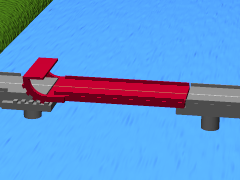Top Qs
Timeline
Chat
Perspective
Bascule bridge
Moveable bridge with a counterweight which keeps the span(s) balanced during the upswing From Wikipedia, the free encyclopedia
Remove ads
A bascule bridge (also referred to as a drawbridge or a lifting bridge) is a moveable bridge with a counterweight that continuously balances a span, or leaf, throughout its upward swing to provide clearance for boat traffic. It may be single- or double-leafed.
The name comes from the French term for balance scale, which employs the same principle. Bascule bridges are the most common type of movable span because they open quickly and require relatively little energy to operate, while providing the possibility for unlimited vertical clearance for marine traffic.
Remove ads
History
Bascule bridges have been in use since ancient times, but until the adoption of steam power in the 1850s, very long, heavy spans could not be moved quickly enough for practical application.
Types
Summarize
Perspective

There are three types of bascule bridge[1] and the counterweights to the span may be located above or below the bridge deck.
The fixed-trunnion (sometimes a "Chicago" bascule) rotates around a large axle that raises the span(s). The Chicago bascule name derives from the location where it is widely used, and is a refinement by Joseph Strauss of the fixed-trunnion.[2] There are 44 movable bridges in Chicago, however 12 are not in operation. The Jackknife Bascule Bridge in Fort William, Ontario (now Thunder Bay, Ontario) was the first double-decked bascule bridge in the world, accommodating rail on the bottom and road/foot traffic on top. It was designed by Joseph Strauss for the Canadian Pacific Railway.
The rolling lift trunnion (sometimes a "Scherzer" rolling lift), raises the span by rolling on a track resembling a rocking-chair base. The "Scherzer" rolling lift is a refinement patented in 1893 by American engineer William Donald Scherzer.[3]
The rarer Rall type combines rolling lift with longitudinal motion on trunnions when opening.[4] It was patented (1901) by Theodor Rall.[2][4][5] One of the few surviving examples is the Broadway Bridge (1913), in Portland, Oregon.[4][6]
- Animation of a double-leaf Strauss fixed-trunnion bridge (based on engineering drawings from the Henry Ford Bridge)
- Animation of a rolling lift bridge (such as the Pegasus Bridge)
- A rolling-lift bascule bridge in the down position
Remove ads
See also
- Double-beam drawbridge
- Drawbridge
- Johnson Street Bridge
- List of bascule bridges
- Moveable bridges for a list of other movable bridge types
- Straussbrug (in Dutch)
References
External links
Wikiwand - on
Seamless Wikipedia browsing. On steroids.
Remove ads





